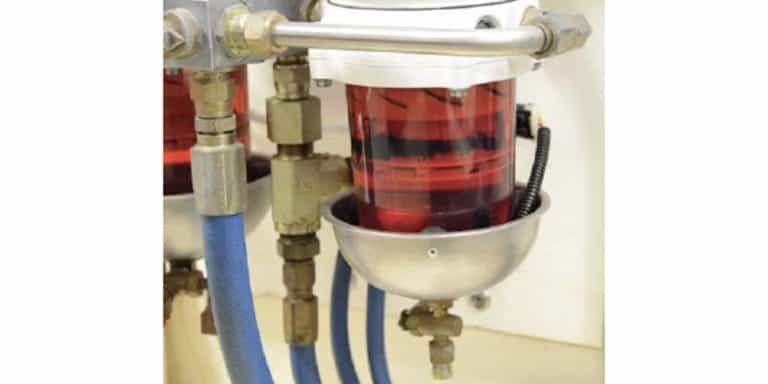Ask Andrew – Identifying and buying boat parts
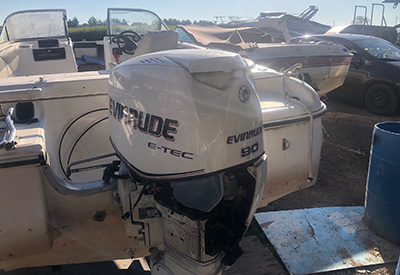
Sept 12, 2019
During the heart of the summer (and into the fall), I get a lot of requests for boat parts. I’ve noticed an interesting trend with parts calls:
“Hi there, I have a 1970’s era Johnson outboard and I need an impeller. Do you have one?”
I’ve learned that boat owners may not know what a mechanic needs to know in order to look up parts. I hope that this issue will put the tools in your hands to speak the same language with your mechanic, while also enabling you to research your needs and price-shop effectively.
The first piece to understand is that engines evolve over time. Manufacturers produce and sell an engine that they feel will perform well. Feedback comes back from dealers and owners that sparks refinement, efficiency, ease of use, cost, ease of repairs, etc. With this information, new models are produced, including (typically) small incremental changes. Each engine manufacturer is aware of what their competition is producing, and as models change and evolve, they are similar to, but also differentiated from rivals’ similar products.
This means that a spark plug, oil filter or impeller may not be the same year-to-year or model-to-model. The same engine manufacturer may use different components across multiple models in a single production year. The reverse is also true: a single oil filter may be found on models over a dozen years, even across multiple manufacturers.
for the boat owner or mechanic to find the engine component (whether its an impeller, spark plug, oil filter, or some other part), some specifics are required. When looking for an engine component, we need a few pieces of information as a starting point:
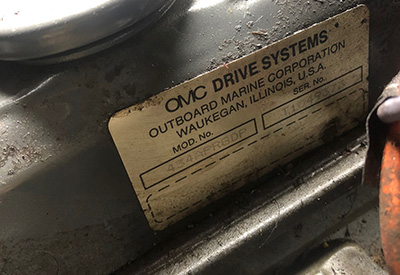 An engine identification plate – this one lists the manufacturer, model number and serial number
An engine identification plate – this one lists the manufacturer, model number and serial number
• Engine manufacturer (Mercury, Yanmar, Westerbeke, Volvo, Johnson, Evinrude, etc)
• The Serial number – this is the most accurate identifier of your engine. It is a specific number assigned only to your engine – each serial number is unique
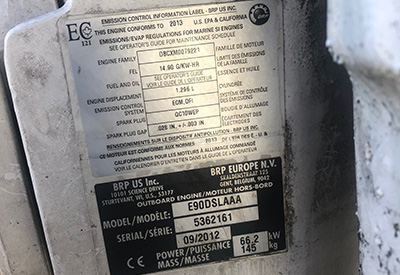 An outboard engine’s serial plate, listing the manufacturer, model number, serial number, and production date
An outboard engine’s serial plate, listing the manufacturer, model number, serial number, and production date
If a serial number isn’t available – the Model Number is used (This is the product run of your engine. There may be hundreds or thousands of serials numbers in a particular model range)
If a model number isn’t available – the year and engine size. In the case of an outboard engine, the engine size is the Horse Power (9.9, 20, 50, 75, 100, 115, etc). In an inboard engine, size is measured by volume (a 3.0L or 4.3L are common examples).
If this information is unknown, there are a few other identifiers that are helpful:
The number of cylinders, and the engine type (gasoline vs diesel, and 2-stroke vs 4-stroke)
Where do you find this information?
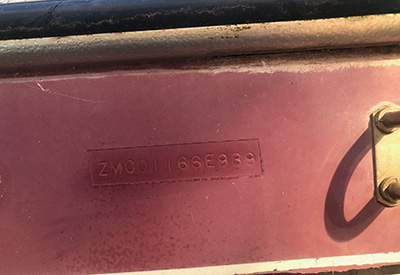 A hull identification number (HIN), found on the starboard side of the transom. The first three letters are a code for the manufacturer, and the last two digits are the production year.
A hull identification number (HIN), found on the starboard side of the transom. The first three letters are a code for the manufacturer, and the last two digits are the production year.
The boat can be identified by a Hull Identification Number (HIN) – which is similar to the VIN number on a car. This number is engraved on the starboard transom of most fiberglass power and sailboats. Smaller open-hulled boats will have a transom plate or load/capacity plate on the transom.
Engine serials numbers are found on an identifying plate on the engine itself. Plates typically list the size, model number, and the serial number
Outboard engines have an identifying plate on the mounting bracket, and will often have the Horsepower highly visible on the engine cowling
 A page from an engine service manual, indicating the location of the serial number, for easy reference.
A page from an engine service manual, indicating the location of the serial number, for easy reference.
Once you have this information – what can you do with it? There are a number of great online resources. Two of my favourites are www.boats.net and www.marineengine.com. They provide detailed diagrams of engines from major manufacturers. Searchable databases, allow you to search by year, horsepower, model and/or serial number, depending on the information available. Diagrams are divided by system, with part names and numbers listed.
The parts listed are OEM parts (original engine manufacturer). Often, in order to buy OEM parts, you need to purchase through a dealer of that brand (ie an Evinrude brand part can only be purchased through an Evinrude dealer). This limits availability, and can be more costly than alternatives. Sierra and Mallory are two examples of large reputable companies that offer aftermarket parts that match very closely with OEM parts. Often, these branded parts can be more easily found, and can be less expensive that their OEM counterparts.
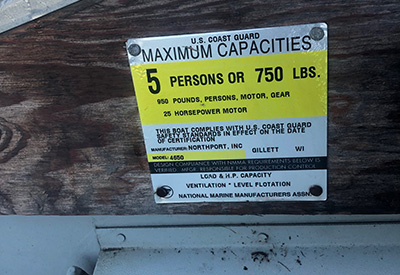 A transom load capacity plate, in an open-hull boat. This lists the manufacturer, the id and Horsepower capacity
A transom load capacity plate, in an open-hull boat. This lists the manufacturer, the id and Horsepower capacity
With the OEM part number in hand, search and price compare the Sierra or Mallory equivalent.
Today’s marinas, dealerships and marine repair techs are more customer focused than ever – they’ll do their best to help. Having the right information on-hand and knowing what information will help them the most will avoid wasted time and money locating the parts that you need.
 Andrew McDonald is the owner of Lakeside Marine Services – a boat repair/maintenance firm based in Toronto. Andrew has worked in the marine industry for 12 years and is a graduate of the Georgian College ‘Mechanical Techniques – Marine Engine Mechanic’ program.
Andrew McDonald is the owner of Lakeside Marine Services – a boat repair/maintenance firm based in Toronto. Andrew has worked in the marine industry for 12 years and is a graduate of the Georgian College ‘Mechanical Techniques – Marine Engine Mechanic’ program.
Questions or comments for Andrew? Email him directly via: askandrew@lakesidemarineservices.ca

